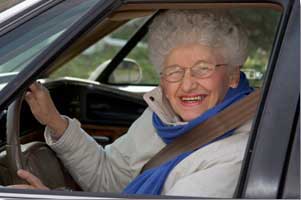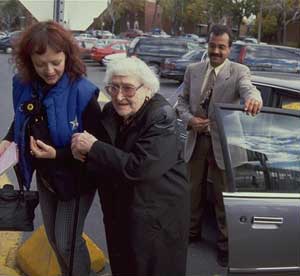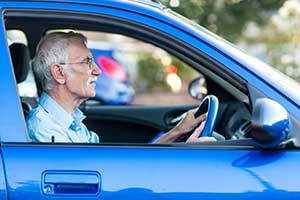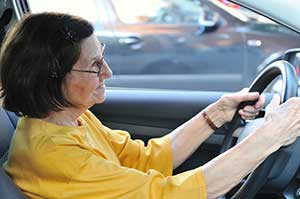Completion requirements
View
Topic Overview

- Many medical conditions, medications and disabilities can affect an older person's ability to drive safely.
- For many people, driving represents independence. Therefore, issues related to driving are very difficult for the older person and for their family caregivers as well.
- There are many warning signs of unsafe driving. The pattern and frequency of these signs are important for determining if someone is not driving safely.
- A formal driving assessment is necessary. A simple road test is not enough.
- When giving up driving, it is important to plan other ways of staying mobile.
- There are resources in the community to help older people stay mobile.
- Driving cessation support groups can help older people and their caregivers to cope with driving issues.
Introduction

- For many people, driving is associated with independence and freedom. The mere mention of having to give up driving is upsetting for many older people. The strong emotions associated with loss of driving privileges makes decisions about driving very difficult.
- As people grow older, illnesses and medications can affect their ability to drive safely. Illnesses that affect driving skills – Alzheimer's disease, a stroke, Parkinson's disease, chronic heart conditions, or complications from diabetes – are more likely to occur as people get older. Also, older people are more likely to take a number of medications, and these too can affect their driving ability.
- Some older people will recognize that their driving skills have declined and stop driving on their own. Others will continue to drive, even when it is no longer safe to do so.
- Caregivers can play an important role in helping older family members recognize when it is no longer safe to drive. However, discussions of driving issues are not easy and often very emotional.
- The information in this section can help caregivers decide when and how to have these conversations with their older family members.
What You Should Know
Warning Signs
 The driving behaviours listed below indicate that driving may
no longer be safe. Use this list to observe the driving of your family member and to keep track of changes over time. Look for a pattern of warning signs and for an increase in their frequency.
The driving behaviours listed below indicate that driving may
no longer be safe. Use this list to observe the driving of your family member and to keep track of changes over time. Look for a pattern of warning signs and for an increase in their frequency.
- Missing traffic lights or road signs (e.g., not stopping at red lights or stop signs)
- Having difficulty merging or changing lanes
- Drifting into other lanes
- Stopping in traffic for no apparent reason
- Driving on the wrong side of the road
- Driving too slowly
- Confusing the gas and the brake pedal
- Being unaware of vehicles, bicycles, or pedestrians
- Easily distracted while driving
- Being honked at by others
- Getting lost while driving (even in familiar locations)
- Delayed response to unexpected events
- Hitting the curb
- Having accidents, near misses, fender benders; getting tickets
- Getting small scrapes on their vehicle or garage
Assessments for Safe Driving
- A formal assessment of driving often is the best method for determining if a person is safe to drive. However, an ordinary road test may not detect driving abilities that have declined to an unsafe level.
- Many driving skills become automatic, such as steering, braking, or shoulder checking.
- A person who appears to be driving well may be relying on habitual responses.
- In Alberta, there is a driving assessment that has been specifically developed for drivers with medical conditions. Your doctor will be able to provide you with the information on how to obtain a referral for that driving assessment.
- For some illnesses, such as dementia (e.g., Alzheimer's disease, vascular disease), driving may be safe in the early stages of the illness, but become unsafe as the illness progresses.
- If your family member has a progressive illness, such as dementia, it will be important for you to continue to monitor their driving behaviour.
- Even if your family member has passed a driving assessment, you should continue to monitor their driving behaviour, using the warning signs provided above.
- You may want to keep a written record of driving behaviours and share these with the family doctor.
Legal Responsibilities

- In Alberta, it is the driver's legal responsibility to notify Driver Fitness and Monitoring (Alberta's Driver Licensing Authority) of a health problem that may interfere with the ability to drive safely.
- As a caregiver, you can remind your family member of their legal responsibility and potential insurance issues if they do not report their health problem.
- In Alberta, doctors are NOT legally required to report patients with medical illnesses that may affect driving. The doctor plays an important role, however, in giving the licensing authority accurate medical information when required.
- In addition, physicians are advised by their professional association (Canadian Medical Association) that they should attend to and report drivers who are potentially unfit to drive.
- However, doctors do NOT make decisions on licences for driving. The licensing authority is responsible for all licensing decisions.
Preparing to Discuss Driving
Do not postpone the conversation because of fear or guilt. Remember, it is more important to avoid crashes that could result in injury or death than to avoid conversations that are unpleasant in nature. Here are some tips to make the discussion more productive.
- Conversation starters. Start the conversation with your feelings and observations. Here are some examples.
- Dad, I'm worried about your driving. I noticed yesterday that you went through a stop sign without stopping and that you had trouble merging in traffic. I also have noticed that there are new dents and scrapes on the car lately.
- Mom, yesterday when we were on our way to the grocery store, you had some close calls. I'm worried about your driving.
- Honey, I've noticed that you don't seem to remember the way home from the grocery store. I'm worried about your getting lost while driving.
- Dad, you've been a good driver all of your life. Now, with your illness, I'm worried that you are no longer the safe driver that you used to be.
- Try to understand your family member's thoughts, feelings, and fears. It may be the first time they have to face and accept what it means to have an illness such as a dementia or cognitive impairment.
- In your discussions, ask how your family member is feeling and acknowledge their emotions. Avoid trying to convince them about the need for stopping driving through rational explanations. Rather, focus on their feelings (e.g., loss of independence, decrease in self-worth, reduced self-esteem, role changes), which are likely the real issue.
- Stay calm during discussions. Staying focused on how the illness has changed their driving will help prevent arguments.
- Rebuttals focused on how good the past driving record has been are better answered by re-focusing on the illness and the present. Acknowledge the past driving record, but emphasize that "things change," and that the illness is changing many things.
Planning to Stay Mobile
 It is important to plan for other ways to stay mobile. Along with
enlisting the aid of family and friends, find out about the transportation options in your community.
It is important to plan for other ways to stay mobile. Along with
enlisting the aid of family and friends, find out about the transportation options in your community.
- Family and friends – Getting rides from family and friends are the main alternatives to driving for older adults. However, there may be conflicting feelings of being a burden or an inconvenience. Suggest doing something in exchange for a ride such as paying for gas, taking the driver to lunch, making casseroles or cakes, and so forth.
- Local Taxi Companies – Check with local taxi companies about discounts for seniors. You may also want to call the taxi company and discuss your family member's needs. Asking for a regular driver and establishing a monthly account may help both you and your family member feel more comfortable about taking taxis.
- Transportation Options in the Community – See what volunteer and paid driver services are available, as well as home delivery options from grocery stores and pharmacies. Check out in-home options for meal support, hair dressing, and so on. Information is available in A Guide to Mobility and Independence: A Comprehensive Listing of In-Home Services and Transportation Providers in Edmonton and Outlying Communities(5th Edition).
A Transportation Budget
- Owning and operating a car is expensive.
- In 2007, it cost an average of about $9,300 to own and operate a mid-size vehicle in Canada.
- That translates into a total of 465 $20 cab rides a year, more than one a day!
- The dollars used to own and operate a private vehicle can be used to keep your family member mobile.
- A form is provided to help your family member calculate the amount spent each year on a car. Download the form in Microsoft Excel or Adobe PDF format.
Driving Cessation Support Groups
- Having to stop driving can be a very difficult time. Specialized driving cessation support groups are available in Edmonton to assist your older family member and their family caregivers as well.
- Research confirms that having a specialized support group makes coping with driving issues easier, both for those having to stop driving and their caregivers or other family members.
- Ask your health care provider for further information on these support groups.
Resources
Edmonton Seniors Coordinating Council (ESCC)
- Website: ESCC is taking a leadership role in facilitating the shared planning and cooperation between agencies that serve seniors in Edmonton.
Driver Evalaution Centres
DriveAble – Many centres throughout the province
- DriveAble is an Edmonton based company that effectively and accurately evaluates cognitive abilities required for fitness-to-drive. It provides driver examinations for people with medical conditions. Doctor’s referral required. Fee for service.
Last modified: Wednesday, 27 April 2022, 9:09 AM